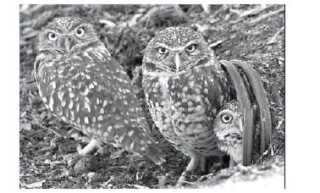On Feb. 26, MARS will host its sixth annual Eaglefest at the Maritime Heritage Centre in Campbell River. Bald eagles are magnificent birds and just one of many species cared for at the MARS rehabilitation centre.
Eaglefest also provides an opportunity to invite a variety of guest speakers including biologists, naturalists and birders to share their knowledge and experiences.
This year we offer a unique opportunity to learn more about one of B.C.’s endangered species, the Burrowing owl, and the program that hopes to successfully breed and return its families back to the wild, sustaining and increasing its populations.
Another of my favourite owls, Burrowing owls are perky and extroverted, with many fascinating habits and characteristics.
These owls are diminutive in size: standing only 21 to 28 centimetres tall, they have a 51 to 61-centimetre wingspan and weigh between 160 and 240 grams.
Habitat for these small owls is very specific: they need dry grassland and valley bottoms that are also inhabited with burrowing mammals. Found in a few locations across the western and mid-United States, they are also found in small areas of B.C. and Alberta. Their natural range in B.C. is less than one per cent of the land in the Kamloops-Thompson-Nicola region and in the Osoyoos area.
As their name suggests, these owls live underground in previously excavated burrows, mainly those of prairie dogs, badgers, ground squirrels and ferrets. With urban expansion and the loss of agricultural lands, Burrowing owls have adapted to golf courses, along airport edges and even to man-made burrows.
Comical and inquisitive, these little owls are perfectly camouflaged to blend in with the sandy and dry grassy areas they inhabit. Their bodies and backs are brown covered with white spots and bars, their legs and underparts are beige with brown barring. Little round bodies sit atop stilt-like legs which are covered with very short feathers; this prevents snagging as they run through the grass when chasing prey. Large yellow eyes stare out from under white eyebrows.
Burrowing owls hunt during the day, but prefer dawn and dusk when the temperature is cooler. Favourite prey includes a variety of insects, scorpions, snakes, grasshoppers, small rodents and birds.
Unlike most owls, Burrowing owls are community dwellers living in small colonies; they will often hunt together, posting a male on “sentry duty” who will raise a vocal alarm if danger approaches, sending the colony scurrying underground to safety. Usually, Burrowing owls hunt from an elevated vantage point, dropping to the ground to pursue the prey on foot.
Burrowing owls are migratory birds and can travel in excess of 3,500 kilometres south to Texas and Mexico. Leaving in September, they return in April for the breeding season.
The male prepares the burrow, removing old material and digging out dirt before relining the burrow with new material. This new material includes dung complete with dung beetle larva to provide the brooding female with food, and its odour deters unwanted visitors.
Burrowing owls were listed as threatened species for many years and upgraded to “endangered” in 1996.
In 1983, the Burrowing Owl Conservation Society of B.C. was established after it was noted that the owls’ populations were declining. Working with the B.C. Ministry of Environment, families of Burrowing owls were transplanted from northern Washington State to the Osoyoos and Vaseaux Lakes areas in hopes they would boost local populations. The program was discontinued in 1989 when returning migrant owls started to dwindle, and so did Washington State’s own populations.
In 1990, a new program was underway, establishing new facilities with specially designed man-made burrows and a captive breeding program. This program studied suitable release sites, and worked with landowners and local municipalities to educate them about the owls and the conservation program.
The program’s goal is to release breeding pairs into suitable locations in hopes that they will reproduce and continue to thrive. So far, the program seems to be reaching its goals.
Urban encroachment into these birds’ living and nesting quarters, plus agricultural spraying, still pose a threat, and expanding road networks also take a toll.
Mike MacIntosh, who runs the program, along with “Beaker,” the Burrowing owl ambassador, will be present at the Eaglefest event, which promises to be a treat for the whole family.
For more on MARS, see www.wingtips.org; for more on the program, visit www.burrowingowlbc.org.
To report injured wildlife, call 1-800-304-9968.
Sandy Fairfield is the educational co-ordinator for the Mountainaire Avian Rescue Society (MARS). The MARS column appears every second Friday.
